Placing tooth colored direct composite restorations is a clinical challenge for even the most experienced clinician. Aside from the technique sensitivities involved in adhesive bonding, determining a shade (whether single or layered) that predictably and precisely matches the natural tooth each and every time can be extremely difficult. Shading for most composite materials relies on a 1950’s technology – the VITA Lumin Shade Guide. The reality is that for many brands, any particular shade, A1 for example, doesn’t precisely match the VITA A1 shade guide, let alone other so-called A1 materials! This can be extremely frustrating for the clinician, especially with a patient that is “picky” about esthetic matching. It is even harder when using bleach shades as there is little to no standardization of those high value materials. Having a universal single shade of composite material that takes the guesswork out of shade selection and matches the majority of clinical situations is something that is at the top of most clinicians’ wish lists.
The Technology of Shade Matching with Composite Restorative Materials
OMNICHROMA (Tokuyama Dental America, Encinitas CA) is the first omnichromatic composite material where one composite will match virtually any tooth shade on any patient. Natural tooth color typically falls in the red-to-yellow area of the color spectrum. Most composite materials depend on the chemical color of the resin to fall in that area of the spectrum to match tooth color esthetically. This means that an A1 composite is chemically colored to specifically match an A1 tooth. Most teeth naturally have multiple shades and color gradients. For this reason, multiple shades are needed to cover all patients and all clinical situations. OMNICHROMA has Smart Chromatic Technology, which utilizes structural color rather than chemical coloration as the main shading mechanism. As light passes through the proprietary spherical fillers in the composite, it is altered along the red and yellow areas of the color spectrum to adapt to and match the color of the patient’s tooth.
A Truly Universal Composite Material: Case Report
The following describes the use of a new composite material, OMNICHROMA (Tokuyama Dental America) that just may fill “the one-color fits all” niche. The 52-year-old patient, whose retracted smile view is shown in Figure 1, reported with a chief complaint that her “right front tooth (she pointed to her right maxillary lateral incisor) was shorter than the same tooth on the opposite side (left maxillary lateral incisor).” Her dental history includes generalized attachment loss (gingival recession) with concomitant bone loss. Several teeth have had Class V composites (not good aesthetic matches!) placed previously due to root surface decay secondary to gingival recession and root surface exposure. Her occlusion was evaluated in all excursions to see if she could accommodate additional length being added to tooth number 12 to satisfy her chief complaint while her case was worked up to address other potential long-term solutions.
Fig. 1

The preoperative shade “appears” to be close to a VITA Lumin B1 shade (Fig. 2). As previously discussed, matching a direct composite material to tooth structure is a clinical challenge in itself, let alone trying to match a portion of a single tooth seamlessly with the surrounding enamel, given internal characterization and the gradation of opacity and translucency in the local area where the composite material overlaps the natural tooth surface. One unique feature of OMNICHROMA is that it allows the dentist not to worry if the tooth to be restored does not exactly match the shade guide, eliminating the unpredictability of choosing an incorrect shade or trying to mix multiple shades in an attempt to match the patient’s tooth. It is also important to create a long bevel of enamel (2-3 millimeters) with about 0.5–0.75 millimeters of actual tooth reduction facially to allow for the restorative material to have sufficient thickness to give it a chance to blend with the natural tooth (Fig. 3). This is also critical so that there is enough enamel to bond sufficiently and retain the restoration. A common mistake is to not reduce (prepare) enough depth to give the composite material sufficient thickness to optically blend with the surrounding tooth or create enough surface area to bond to. The proximal margins of the preparation extend to the proximal-facial line angles respectively. This is because it is easier to blend restorative material with tooth structure if the margin is located at the intersection of two geometric surfaces of the tooth rather than in the middle of the facial surface. There is no need in this case to involve the proximal contact areas in the preparation. The horizontal margin located at the junction of the incisal and middle third of the tooth is curved mesial to distal to make the restorative material margin less visible after finishing.
Fig. 2

Fig. 3
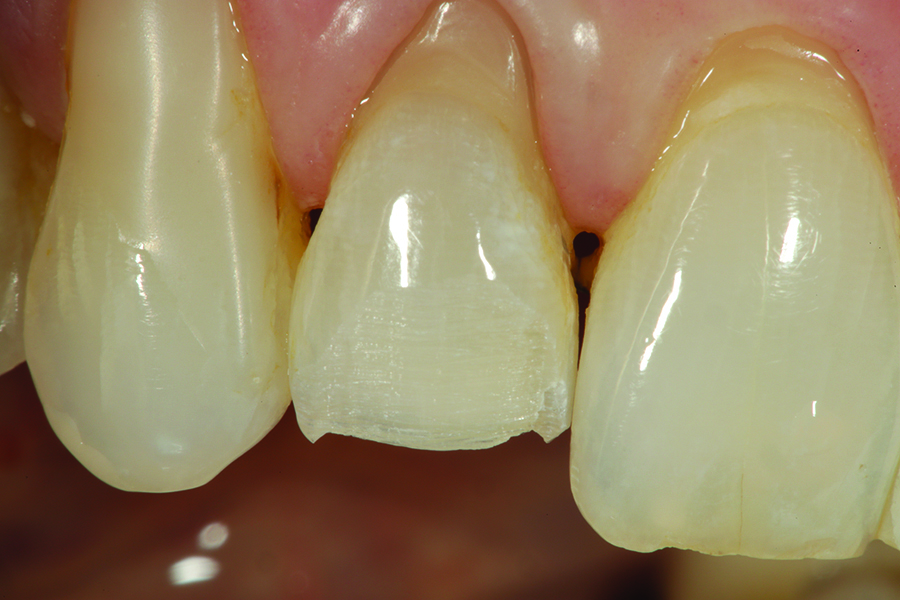
Once the preparation is completed, mylar strips are placed in the contact areas both mesial and distal in preparation for the bonding process. A universal bonding agent (Tokuyama Universal Bond: Tokuyama Dental America) is used dispensing a drop of both A and B into a disposable mixing well (Fig. 4). While compatible for total etch, self-etch, and selective etch techniques, this bonding agent is unique in that it requires no light activation or curing or 10-20 seconds of agitation on the preparation surface. Apply 5 seconds of weak air, then 5 seconds of medium air. This helps eliminate some of the technique sensitivity for the clinician that can adversely affect the bond strengths of the restorative material to the tooth (Fig. 5).
Fig. 4

Fig. 5

A thin layer of OMNICHROMA BLOCKER (Tokuyama Dental America) is placed to increase the tooth to the desired length and to help eliminate “shade matching” interference from the surrounding teeth and gingival tissues (Fig. 6). An interproximal abrasive strip (ContacEZ) is used after polymerization both mesially and distally to ensure tooth separation and mylar strips are repositioned prior to placement of the final layer of composite (Fig. 7). Next, OMNICHROMA is placed and contoured using a composite plastic filling instrument (Fig. 8). Notice after placement immediately how the composite takes on the shade of the surrounding tooth. Remember, this is a one shade system! This was not choosing a B1 composite based on the initial VITA shade tab (Fig. 2) then hoping it was an aesthetic match.
Fig. 6
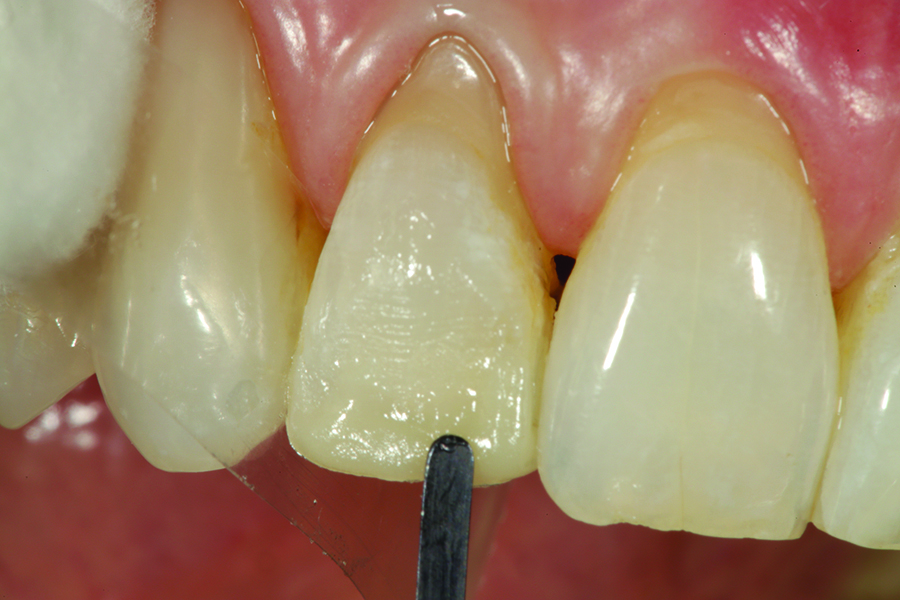
Fig. 7
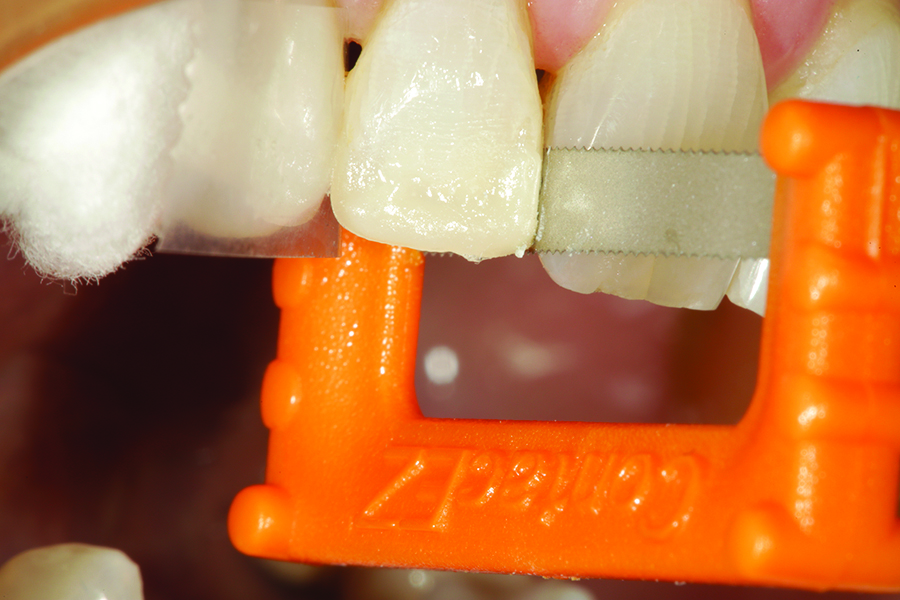
Fig. 8

Once polymerized, contouring is initiated with an 8-fluted carbide composite finishing bur (FS 9: Komet USA) (Fig. 9). Next, contouring of the proximal facial line angles and facial surface is continued using a succession of grits (medium, fine, to super fine) of abrasive discs (Super Snap Rainbow Abrasives: Shofu Dental, San Marcos CA). The mesial facial area clearly shows that it is virtually impossible to detect any variation in shade between the OMNICHROMA restorative material and the adjacent tooth structure even at significant magnification. At normal conversational distances, the restoration will be imperceptible. Rubber abrasives (A.S.A.P. Polishers: Clinical Research Dental) are used to polish proximal and facial surfaces of the restorative material (Fig. 11). These polishers are used with water at about 6-8,000 RPM rotating from restorative material toward tooth structure. Figure 12 shows a final retracted facial view of the completed restoration. OMNICHROMA allows the dentist to achieve a beautiful aesthetic match with composite without having to choose a traditional VITA shaded composite material that may or may not precisely match the tooth being restored.
Fig. 9
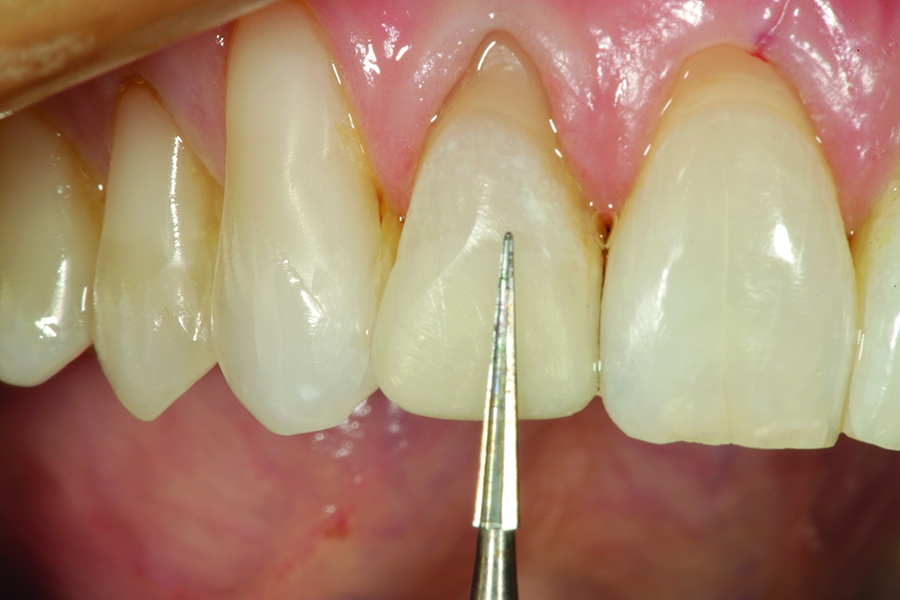
Fig. 10

Fig. 11
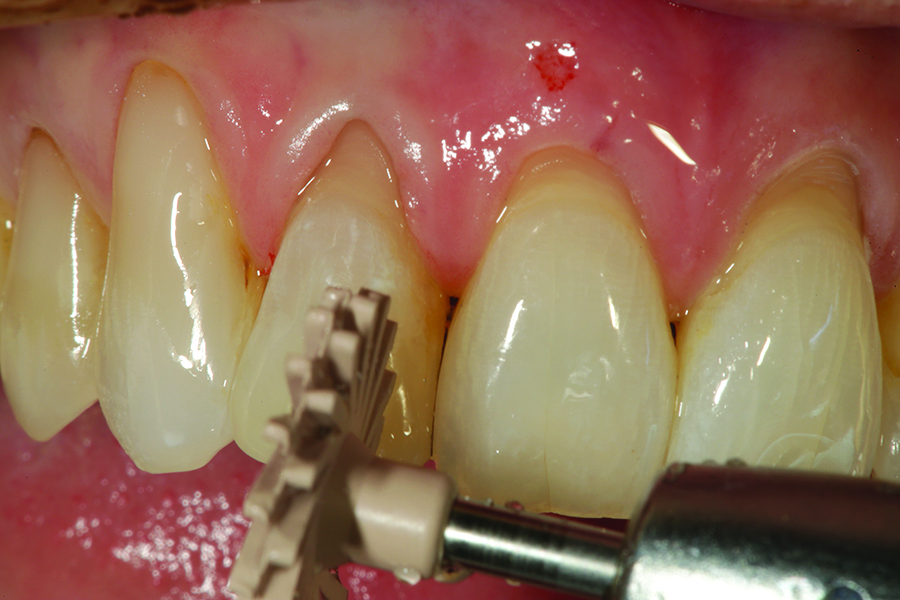
Fig. 12

Conclusion
A case has been presented demonstrating the use of a new composite material (OMNICHROMA by Tokuyama Dental America) that helps take the “guesswork” out of composite shade selection for the clinician. Increasing the chance for an excellent aesthetic match for direct composite materials can help take some of the stress and unpredictability out of placing these types of
restorations.
Oral Health welcomes this original article.
About the Author
 Dr. Robert A. Lowe graduated magna cum laude from Loyola University School of Dentistry in 1982 and was a Clinical Professor in Restorative Dentistry until its closure in 1993. He maintains a private practice in Charlotte, North Carolina, lectures internationally, and publishes on aesthetic and restorative dentistry. Dr. Lowe i has Fellowships in the AGD, ICD, ADI, ACD, IADFE, and ASDA. In 2004, he received the Gordon Christensen Outstanding Lecturers Award, and in 2005, Diplomat status on the American Board of Esthetic Dentistry. Dr. Lowe can be reached at 704-450-3321 or at boblowedds@aol.com.
Dr. Robert A. Lowe graduated magna cum laude from Loyola University School of Dentistry in 1982 and was a Clinical Professor in Restorative Dentistry until its closure in 1993. He maintains a private practice in Charlotte, North Carolina, lectures internationally, and publishes on aesthetic and restorative dentistry. Dr. Lowe i has Fellowships in the AGD, ICD, ADI, ACD, IADFE, and ASDA. In 2004, he received the Gordon Christensen Outstanding Lecturers Award, and in 2005, Diplomat status on the American Board of Esthetic Dentistry. Dr. Lowe can be reached at 704-450-3321 or at boblowedds@aol.com.
RELATED ARTICLE: Why Thousands Of Doctors Are Trusting OMNICHROMA
Follow the Oral Health Group on Facebook, Instagram, Twitter and LinkedIn for the latest updates on news, clinical articles, practice management and more!












